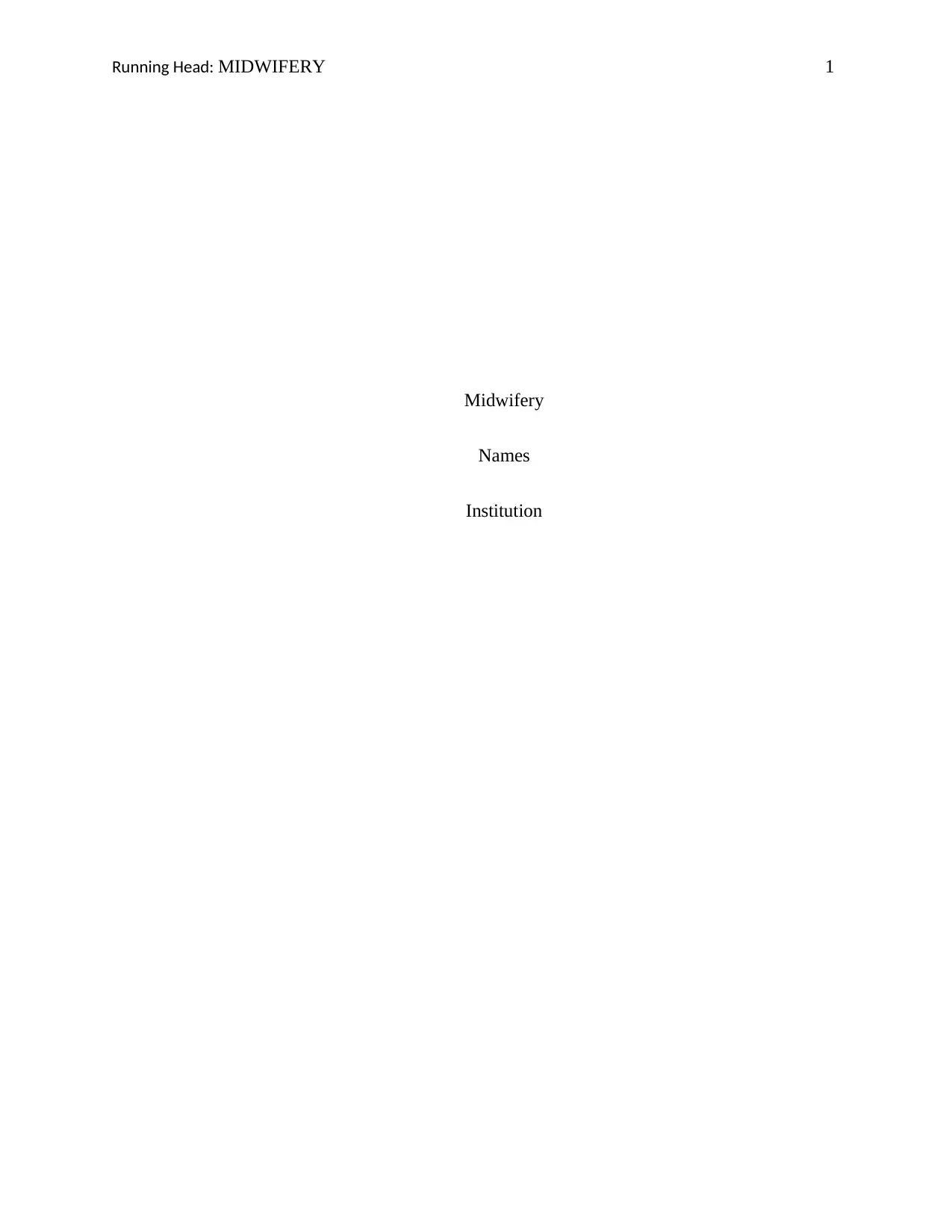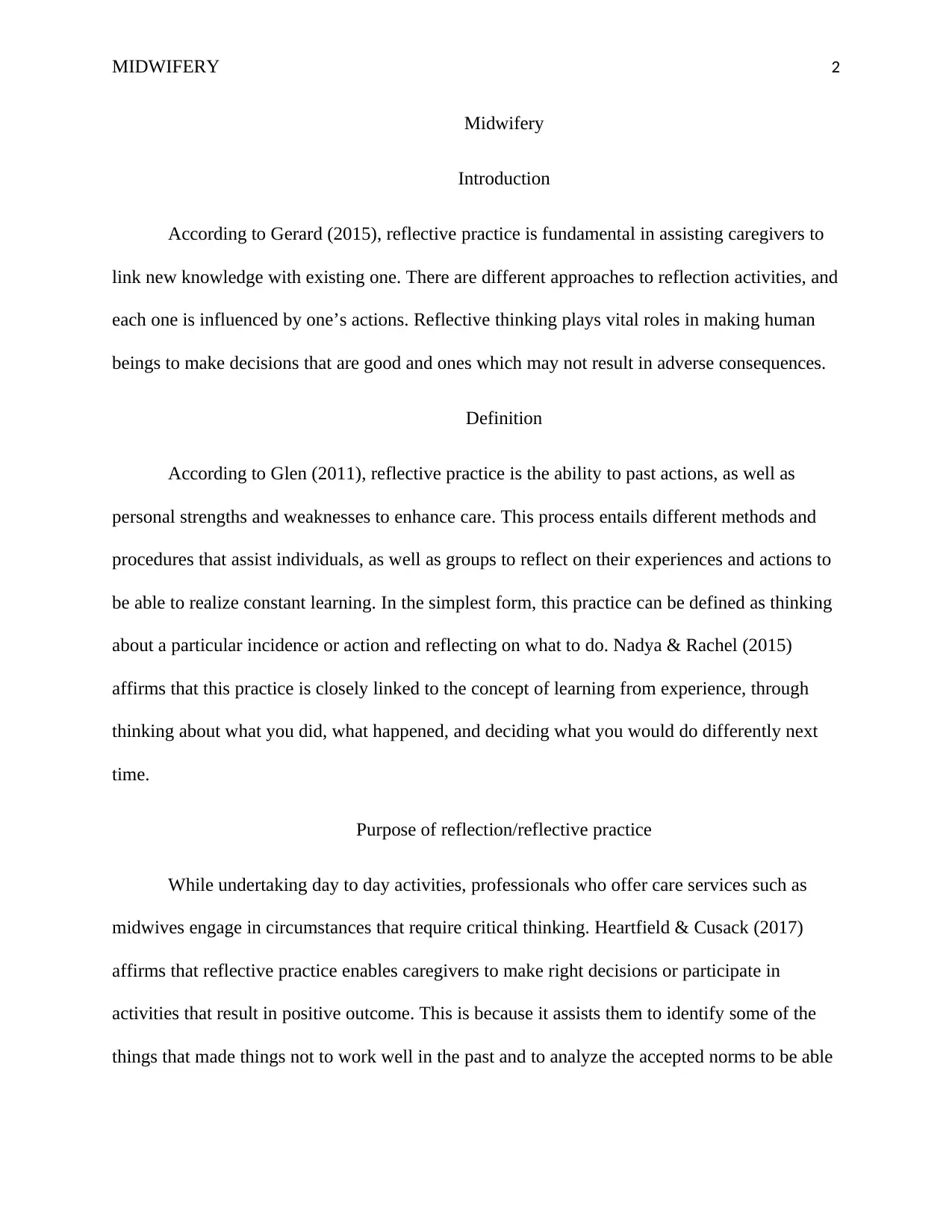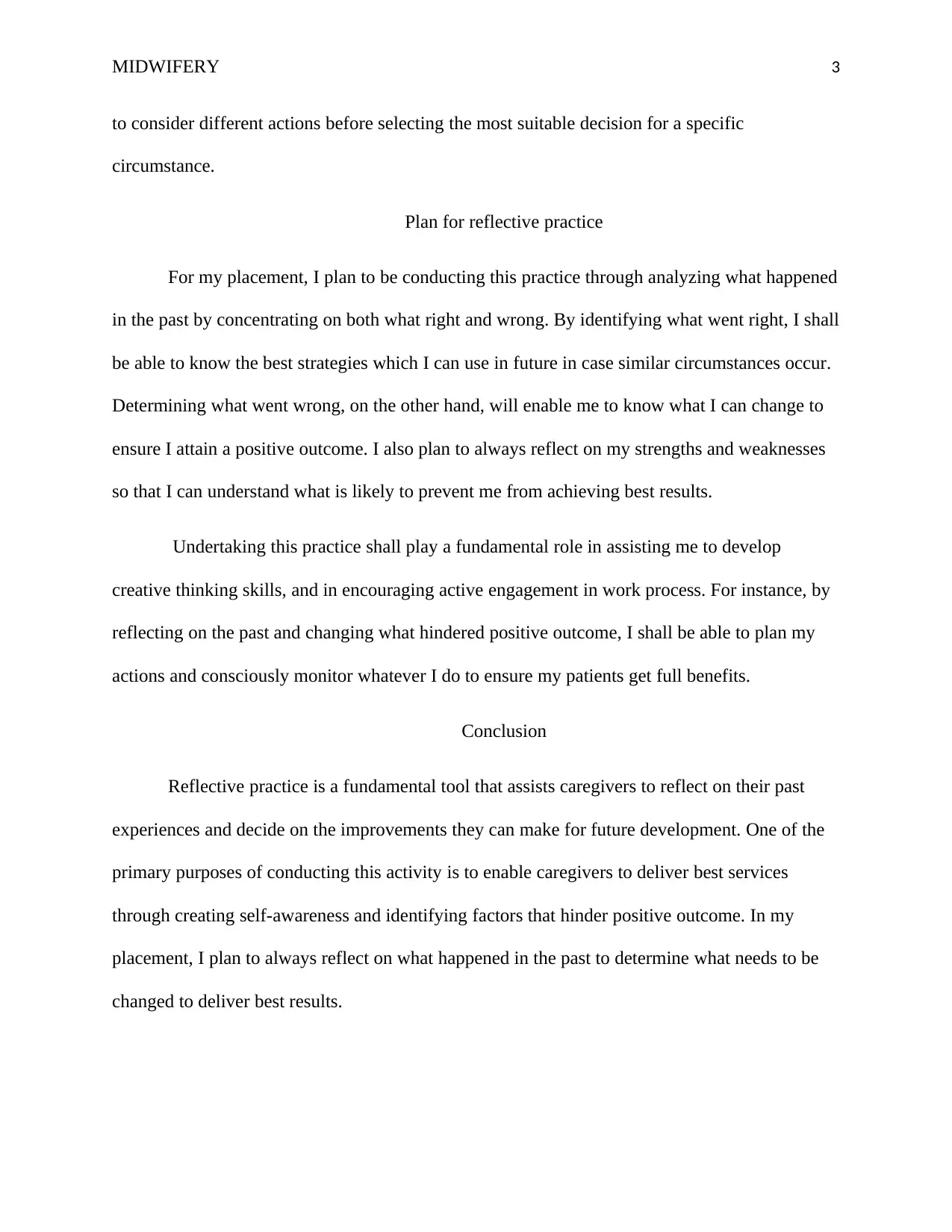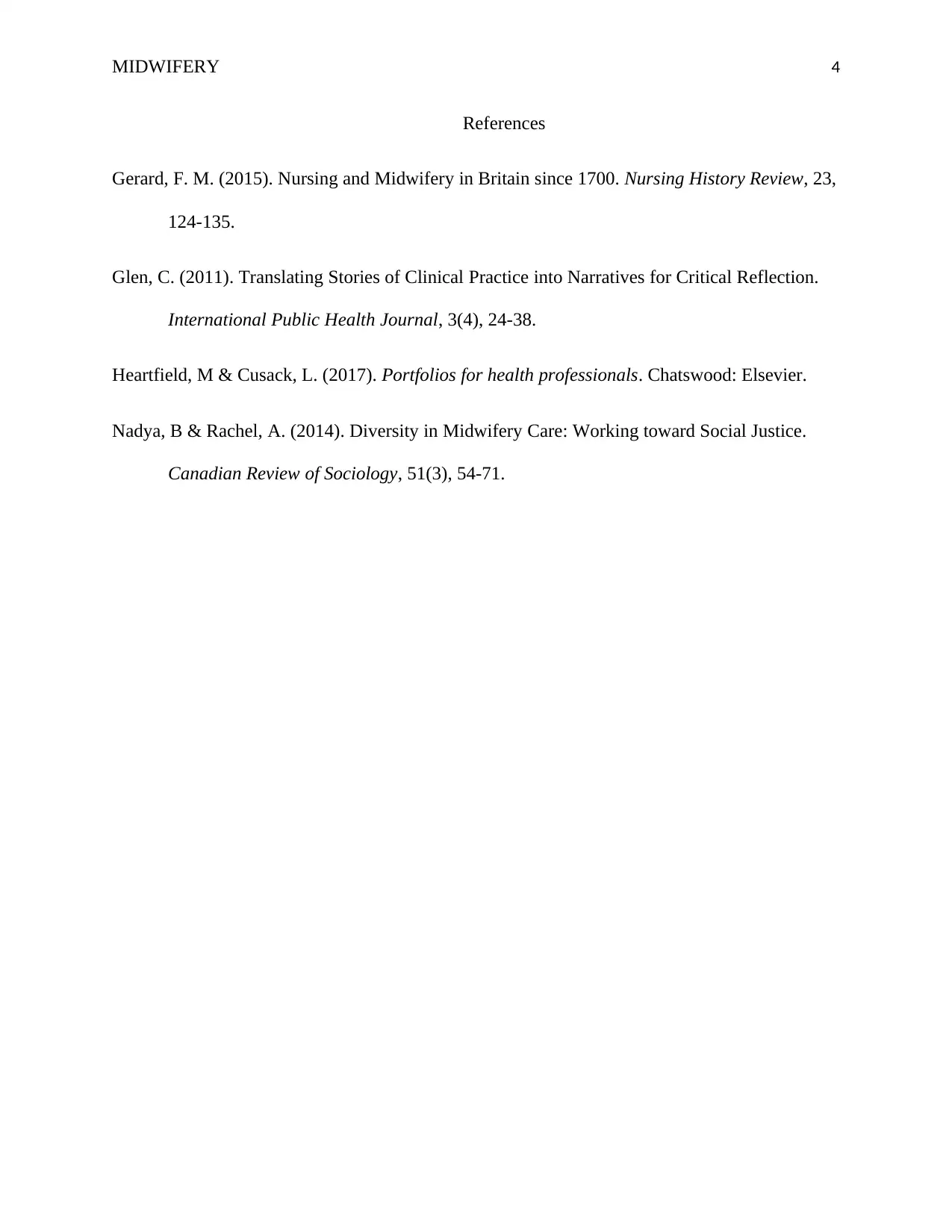Assignment on Midwifery (pdf)
VerifiedAdded on 2021/06/16
|4
|668
|44
AI Summary
Contribute Materials
Your contribution can guide someone’s learning journey. Share your
documents today.

Running Head: MIDWIFERY 1
Midwifery
Names
Institution
Midwifery
Names
Institution
Secure Best Marks with AI Grader
Need help grading? Try our AI Grader for instant feedback on your assignments.

MIDWIFERY 2
Midwifery
Introduction
According to Gerard (2015), reflective practice is fundamental in assisting caregivers to
link new knowledge with existing one. There are different approaches to reflection activities, and
each one is influenced by one’s actions. Reflective thinking plays vital roles in making human
beings to make decisions that are good and ones which may not result in adverse consequences.
Definition
According to Glen (2011), reflective practice is the ability to past actions, as well as
personal strengths and weaknesses to enhance care. This process entails different methods and
procedures that assist individuals, as well as groups to reflect on their experiences and actions to
be able to realize constant learning. In the simplest form, this practice can be defined as thinking
about a particular incidence or action and reflecting on what to do. Nadya & Rachel (2015)
affirms that this practice is closely linked to the concept of learning from experience, through
thinking about what you did, what happened, and deciding what you would do differently next
time.
Purpose of reflection/reflective practice
While undertaking day to day activities, professionals who offer care services such as
midwives engage in circumstances that require critical thinking. Heartfield & Cusack (2017)
affirms that reflective practice enables caregivers to make right decisions or participate in
activities that result in positive outcome. This is because it assists them to identify some of the
things that made things not to work well in the past and to analyze the accepted norms to be able
Midwifery
Introduction
According to Gerard (2015), reflective practice is fundamental in assisting caregivers to
link new knowledge with existing one. There are different approaches to reflection activities, and
each one is influenced by one’s actions. Reflective thinking plays vital roles in making human
beings to make decisions that are good and ones which may not result in adverse consequences.
Definition
According to Glen (2011), reflective practice is the ability to past actions, as well as
personal strengths and weaknesses to enhance care. This process entails different methods and
procedures that assist individuals, as well as groups to reflect on their experiences and actions to
be able to realize constant learning. In the simplest form, this practice can be defined as thinking
about a particular incidence or action and reflecting on what to do. Nadya & Rachel (2015)
affirms that this practice is closely linked to the concept of learning from experience, through
thinking about what you did, what happened, and deciding what you would do differently next
time.
Purpose of reflection/reflective practice
While undertaking day to day activities, professionals who offer care services such as
midwives engage in circumstances that require critical thinking. Heartfield & Cusack (2017)
affirms that reflective practice enables caregivers to make right decisions or participate in
activities that result in positive outcome. This is because it assists them to identify some of the
things that made things not to work well in the past and to analyze the accepted norms to be able

MIDWIFERY 3
to consider different actions before selecting the most suitable decision for a specific
circumstance.
Plan for reflective practice
For my placement, I plan to be conducting this practice through analyzing what happened
in the past by concentrating on both what right and wrong. By identifying what went right, I shall
be able to know the best strategies which I can use in future in case similar circumstances occur.
Determining what went wrong, on the other hand, will enable me to know what I can change to
ensure I attain a positive outcome. I also plan to always reflect on my strengths and weaknesses
so that I can understand what is likely to prevent me from achieving best results.
Undertaking this practice shall play a fundamental role in assisting me to develop
creative thinking skills, and in encouraging active engagement in work process. For instance, by
reflecting on the past and changing what hindered positive outcome, I shall be able to plan my
actions and consciously monitor whatever I do to ensure my patients get full benefits.
Conclusion
Reflective practice is a fundamental tool that assists caregivers to reflect on their past
experiences and decide on the improvements they can make for future development. One of the
primary purposes of conducting this activity is to enable caregivers to deliver best services
through creating self-awareness and identifying factors that hinder positive outcome. In my
placement, I plan to always reflect on what happened in the past to determine what needs to be
changed to deliver best results.
to consider different actions before selecting the most suitable decision for a specific
circumstance.
Plan for reflective practice
For my placement, I plan to be conducting this practice through analyzing what happened
in the past by concentrating on both what right and wrong. By identifying what went right, I shall
be able to know the best strategies which I can use in future in case similar circumstances occur.
Determining what went wrong, on the other hand, will enable me to know what I can change to
ensure I attain a positive outcome. I also plan to always reflect on my strengths and weaknesses
so that I can understand what is likely to prevent me from achieving best results.
Undertaking this practice shall play a fundamental role in assisting me to develop
creative thinking skills, and in encouraging active engagement in work process. For instance, by
reflecting on the past and changing what hindered positive outcome, I shall be able to plan my
actions and consciously monitor whatever I do to ensure my patients get full benefits.
Conclusion
Reflective practice is a fundamental tool that assists caregivers to reflect on their past
experiences and decide on the improvements they can make for future development. One of the
primary purposes of conducting this activity is to enable caregivers to deliver best services
through creating self-awareness and identifying factors that hinder positive outcome. In my
placement, I plan to always reflect on what happened in the past to determine what needs to be
changed to deliver best results.

MIDWIFERY 4
References
Gerard, F. M. (2015). Nursing and Midwifery in Britain since 1700. Nursing History Review, 23,
124-135.
Glen, C. (2011). Translating Stories of Clinical Practice into Narratives for Critical Reflection.
International Public Health Journal, 3(4), 24-38.
Heartfield, M & Cusack, L. (2017). Portfolios for health professionals. Chatswood: Elsevier.
Nadya, B & Rachel, A. (2014). Diversity in Midwifery Care: Working toward Social Justice.
Canadian Review of Sociology, 51(3), 54-71.
References
Gerard, F. M. (2015). Nursing and Midwifery in Britain since 1700. Nursing History Review, 23,
124-135.
Glen, C. (2011). Translating Stories of Clinical Practice into Narratives for Critical Reflection.
International Public Health Journal, 3(4), 24-38.
Heartfield, M & Cusack, L. (2017). Portfolios for health professionals. Chatswood: Elsevier.
Nadya, B & Rachel, A. (2014). Diversity in Midwifery Care: Working toward Social Justice.
Canadian Review of Sociology, 51(3), 54-71.
1 out of 4
![[object Object]](/_next/static/media/star-bottom.7253800d.svg)




